Ageratina adenophora
Common name
Mexican devil
Synonyms
Eupatorium adenophorum, Eupatorium glandulosum
Family
Asteraceae
Flora category
Vascular – Exotic
Structural class
Herbs - Dicotyledonous composites
NVS code
The National Vegetation Survey (NVS) Databank is a physical archive and electronic databank containing records of over 94,000 vegetation survey plots - including data from over 19,000 permanent plots. NVS maintains a standard set of species code abbreviations that correspond to standard scientific plant names from the Ngä Tipu o Aotearoa - New Zealand Plants database.
AGEADE
Conservation status
Not applicable
Habitat
Terrestrial. Lightly shaded frost-free areas, e.g. forest edges, shrublands, wetlands, streamsides, open forest, inshore and offshore islands, gumlands, slips, alluvial flats, coast and estuaries.
Wetland plant indicator status rating
Information derived from the revised national wetland plant list prepared to assist councils in delineating and monitoring wetlands (Clarkson et al., 2021 Manaaki Whenua – Landcare Research Contract Report LC3975 for Hawke’s Bay Regional Council). The national plant list categorises plants by the extent to which they are found in wetlands and not ‘drylands’. The indicator status ratings are OBL (obligate wetland), FACW (facultative wetland), FAC (facultative), FACU (facultative upland), and UPL (obligate upland). If you have suggestions for the Wetland Indicator Status Rating, please contact: [Enable JavaScript to view protected content]
FAC: Facultative
Commonly occurs as either a hydrophyte or non-hydrophyte (non-wetlands).
Detailed description
Erect, many-stemmed herb to subshrub to 1-2 m. Perennial fibrous rootstock. Stems often die back in winter, densely covered in stalked sticky hairs, usually purple, becoming woody, with branches in opposite pairs, often with galls formed by parasitic fly. Leaves in opposite pairs, 55-80 x 35-70 mm, diamond-shaped, margins irregularly roundtoothed. Flowers small, white, 5-7 mm diam, in dense terminal clusters, Aug-Dec. Seeds black, 5- angled, 1.8 mm long.
Similar taxa
Can be distinguished from mist flower ( A. riparia) by the broader leaf shape and stalked glandular hairs without stripes (DoC, 1998).
Flowering
August, September, October, November, December, January, February, March.
Flower colours
White
Fruiting
Late Summer-Autumn? (Timmins & MacKenzie 1995).
Year naturalised
1931
Origin
Mexico
Etymology
adenophora: From the Greek aden ’ gland’ and phoreo ‘to bear’
Reason For Introduction
Ornamental.
Life Cycle Comments
Perennial. The plant has a life span of a few years and produces seed (Timmins & MacKenzie 1995) drooping stems can layer. Seed dispersal is by wind, water, vertebrates and road mowers.
Tolerances
The plant is intolerant to shade, frost and poor drainage(?) and tolerant to drought (Timmins & MacKenzie 1995).





